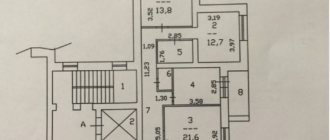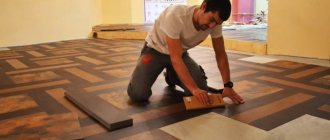An important part of comfort, coziness, and psychological sensations is the height of the ceilings in a private house. There are standards and rules that declare the specified parameter in relation to the purpose of the room. The height of the ceilings is of particular importance when it comes to designing a private house. For apartments, this parameter is strictly regulated - this range is from 2.5 to 2.7 meters.
Ceiling height in the living room
Correct planning further eliminates the issue of installing decorative elements inside the room. When solving a problem, as a rule, they prefer the standard option. The layout of the space in the boiler room requires special attention. It is possible to determine whether the choice was made correctly only after check-in. However, you can pay attention to important details and estimate the positive and negative aspects during design.
Standard ceiling heights
The main regulatory document regulating the height of ceilings in apartment buildings is SNiP 31-01-2003, according to which the parameter in question depends on:
- Climatic conditions in a particular area;
- Purpose and type of room.
Climatic region is a parameter that takes into account the average temperature profile for each month, as well as the level of humidity and wind direction. According to SNiP 01/23/99, there are four districts divided into 16 zones. The zones are arranged in descending order - the higher the category, the milder the climate in this zone.
According to the standard, in the warmest zones the ceiling must be at a height of at least 2.7 meters, and for other areas the minimum ceiling height is 2.5 meters. These parameters are not formed out of the blue - complex calculations show that ensuring a normal microclimate and air exchange in rooms is possible only if the actual parameters correspond to the nominal ones.
In rooms located in the attic, the ceiling can be lowered, but the amount of reduction is also regulated - the ceiling level can deviate from the standards only over half the area of the room. In passage rooms (for example, corridors), the ceiling height according to GOST can be reduced to 2.1 m - this figure will be quite sufficient for the normal movement of people.
The maximum ceiling height is not specified by regulatory documents, but in practice the ceiling is rarely raised above 3.2 meters. In older buildings, the size of the rooms can be increased, as a result of which the ceiling height can exceed 4 meters.
When arranging your home yourself, you need to choose the ceiling height taking into account the parameters described above and the area of the premises. For example, for small and narrow rooms it is not recommended to use high ceilings - they will create a rather unpleasant feeling. In large rooms, this rule works in the opposite direction - for a large hall, a ceiling over 3 meters high is optimal.
The poor cry too
- How to increase the height of a room in an apartment building?
Here are a couple of the most obvious solutions:
- Remove the wooden flooring along with the joists. It will allow you to win at least ten centimeters. To level the slab floor, use a self-leveling floor; for sound insulation, use linoleum with insulation or laminate with a thick (5-10 mm) and dense (for example, cork) backing;
Removal of flooring and joists.
- Remove the screed poured onto the ceiling. Its typical thickness is 5 - 8 cm. On the first floors, under a reinforced screed, a layer of insulation 3-5 cm thick is often laid; in this case, the ceiling height will increase by an impressive 8 - 13 cm.
Dismantling the screed.
Of course, after removing the insulated screed, you will have to seriously worry about insulating the basement under the apartment.
- How to make a room taller in a wooden house?
And here I will offer you a couple of ideas:
- Hem the ceiling not along the beams, but along the cranial bars stuffed onto their side surfaces;
The clapboard hemming is made not along the beams, but between them.
- Cut out the floor beams and lay an insulated screed on the ground on top of the concrete preparation (a layer of low-grade concrete).
In the latter case, window and door openings will rise noticeably relative to the floor level. Be prepared to cut out an additional crown and replace window and door units.
Thanks to the underground floor, you can gain up to half a meter in height.
- How to visually increase the height of the ceiling if it is not possible to physically raise it?
Play with contrast. Human vision has an interesting feature: light objects seem more distant to him than they actually are, dark objects seem closer. If you paint the ceiling white or just the lightest possible color, it will seem higher to you; the effect can be emphasized by decorating the walls with a dark finish.
The opposite is also true. A dark ceiling with light walls will look lower than it actually is.
A couple more tricks:
- Tall baguettes, moldings or simply white stripes at the top of the walls will further increase the apparent height of the ceiling;
A white ceiling with a wide snow-white baguette will appear higher.
- Gloss and, in general, any finish that has a mirror effect will work in the same way. All surfaces that fully or partially reflect the interior of the room will deceive your vision and make the ceiling surface appear more distant than it actually is.
The picture clearly shows how gloss affects the apparent height of the room.
Bathroom. The ceiling is decorated with mirror tiles.
- How to visually increase the height of the ceiling if major renovations to the room are not planned?
Lighting affects the visual perception of distances in the same way as light finishing colors. By brightly lighting the ceiling with relatively dark walls, you will again make it higher. For this purpose, you can use spotlights, spot lights or a bright LED strip hidden behind the ceiling plinth.
The illumination is made by LED strip laid on a baguette.
"Stalin" and older houses
Older buildings traditionally did not skimp on space, so the area and height of each individual room was quite large. The thing is that the historical period in which such houses were built was not characterized by the desire to provide all families with at least a small apartment.
The ceiling height standards in "Stalinka" buildings vary from 3.3 to 3.6 m, while the ceilings themselves are usually decorated with various decorative elements - for example, stucco molding or cornices. When installing suspended ceilings in such apartments, due to the large amount of finishing, it is necessary to significantly reduce their level.
Certain difficulties also arise due to the fact that wooden elements were often used to make floors in old houses, and the wiring was laid externally - repairing the ceiling in such conditions is not very easy, so you have to invest much more money in repairs.
However, an increased amount of free space has its advantages - in a tall room with a large area, you can arrange any style, and it will look quite appropriate. An excellent option, for example, would be a multi-level suspended ceiling, decorated with a variety of decorative elements.
Suspended ceilings of any configuration are generally very suitable for rooms with a high ceiling height - the availability of space allows you to painlessly reduce the volume of the room. Finishing the very basic ceiling in such rooms would be a bad decision - the existing ceilings usually have a lot of “congenital” defects, which are very difficult to hide.
"Khrushchev"
During the reign of Khrushchev, serious changes occurred in the construction industry. Thus, the main task set for the developers was to provide all families with their own housing. Of course, with such introductory housing, it was necessary to seriously reduce the housing, and the result of the design work was the “Khrushchev” - apartments with a very modest area and minimal ceiling height.
In classical apartments of the period under review, the ceiling was 2.5 m from the floor level. Individual apartments located on the first or last floor could have ceilings 0.1 m higher than the designated indicator. In the northern regions, the height from floor to ceiling in an apartment could reach 2.7 m.
For the manufacture of interfloor ceilings in Khrushchev-era buildings, reinforced concrete panels were used, which are easy to construct, quite reliable in operation and can be faced without problems. Accordingly, finishing ceilings usually came down to processing the joints in the slabs and applying whitewash.
Stretch ceilings, despite the reduction in ceiling height (even the simplest structures “eat up” about 5 cm), are used quite often in Khrushchev-era buildings. Lath or plasterboard structures are much less common - they require much more space to install. There is no need to talk about multi-level structures - they are completely inappropriate in such conditions.
By installing a suspended ceiling, you can try to compensate for the loss of free space by visually expanding the room. To achieve this effect, you need to very wisely select the colors and texture of the ceiling structure. It is better to use spotlights as lighting devices - installing large chandeliers in Khrushchev buildings is completely impractical.
Tension, suspended
- What is the minimum height of a stretch ceiling from the ceiling of the room??
Ideally, about 4 centimeters. The distance that a suspended ceiling eats up can increase in two cases:
- If the slab floor has noticeable irregularities and differences. In this case, a distance of 4 cm is set aside from the bottom point of the overlap;
Harpoon fastening of the tension fabric.
- If the space between the canvas and the ceiling is used for the installation of built-in lamps, ventilation ducts or air conditioning lines. Everything here is determined by the dimensions of the lamps or the cross-section of the utilities that you plan to lay.
Built-in lights forced the canvas to move down.
- How much height will a suspended plasterboard structure take up?
With an even ceiling - approximately the same amount as the suspended ceiling takes up, about 4 cm. The lowering height is the sum of the height of the walls of the ceiling profile (27 mm) and the thickness of the plasterboard (12.5 mm for the wall and 9.5 mm for the ceiling).
The sheathing of the plasterboard suspended flow is separated from the ceiling at a minimum distance.
- How much will the ceiling level decrease when covered with plastic panels?
When constructing a suspended structure using a profile frame, the same simple arithmetic applies as in the case of gypsum plasterboard: the profile thickness is 27 mm, the panel thickness is 7 - 10 mm. Total 34-37 mm.
Finishing with panels on the frame.
However, on a relatively flat floor, the panels can be attached not to a frame, but to glue or silicone sealant. Then only 7-10 mm (panel thickness) is lost.
"Brezhnevki"
After some time, when Brezhnev came to power, along with him came the desire of people to live in more comfortable conditions. This desire is reflected in state building regulations. Thus, the standard ceiling height in an apartment has increased to 2.6-2.7 m, and the rooms themselves have become larger. In addition, standard designs were supplemented with separate hallways, as well as built-in wardrobes and mezzanines. There were no other differences from the apartments of the Khrushchev era - all the same brick walls, panel ceilings, simplified layout and complete absence of any decoration.
Brezhnevkas are quite convenient in terms of repair. The ceilings in such apartments are simple and fairly flat, which allows you to use any available materials and solutions for finishing. The difference between the base ceiling and the minimum possible is about 15 cm - and this distance is quite enough for both simple finishing and for arranging suspended structures.
How to obtain permission for individual housing construction? What does a developer need to know?
Limiting authorities follow the development procedure and approve documents for individual housing construction according to RSN 70-88. Thanks to them, not only the accuracy of site development is determined, but also the layout of the home and auxiliary buildings. This project needs to be carefully considered, because what is not shown in the plan will be recognized as an unauthorized structure and must be demolished or re-approved.
Without permission, that is, before the plan is approved and documents are received, work should not begin, otherwise serious problems may arise. In order to find out exactly what documents will be required to start construction, you should read the “Code of Rules for Design and Construction SP 11-III-99”.
In order to obtain permission, you need to contact the BTI or the city architectural department to provide:
- application for planning permission;
- documents establishing the right to use the site;
- certificate of field determination of boundaries, placement of buildings, etc.;
- cadastral plan of the site;
- House project.
Once issued, the permit is valid for 10 years.
Buildings made of panels and blocks
Initially, panel houses were built under Khrushchev. The standard configuration of such houses assumed that they would have five floors, and they would be built in the southern regions. The standard ceiling height in panel houses was about 2.5 meters, and the walls were built of brick. By and large, these buildings were very similar to typical “Khrushchev” buildings - there was little free space, and there was not enough natural light even on sunny days.
Renovation of houses made of panels and blocks occurred already in the 80s. The new buildings were distinguished by an increased number of floors, large area of premises and high ceilings - their minimum height was 2.65 m, and in some cases reached 2.75 m. Even with a superficial examination, we can safely say that such apartments were much more convenient.
This convenience was evident not only during the operation of the apartments, but also during renovations. Thus, finishing the ceiling was extremely simple - initially the surface of the floors was flat, so it could be arranged in any way. The high ceilings typical of such apartments made it possible to use suspended and suspended ceiling structures.
The most noticeable disadvantage of panel houses is the low level of sound and noise insulation. That is why during renovations it is always necessary to use high-quality materials to reduce the noise level entering the apartment from the outside.
Modern apartments
Today, apartments and premises in multi-storey buildings have a variety of layouts, and modern technologies are used in the construction process. Due to this, a fairly wide variability in the dimensions of the premises is ensured - for example, the height of the ceilings in the office can completely “float” depending on the purpose of a particular room. Diversity allows you to choose apartments in a wide range of prices - with a minimum budget you will have to choose among economy-class apartments, and the ability to invest more money allows you to purchase housing that will have a larger area and a high degree of comfort.
The difference between cheap and expensive apartments is obvious:
- When building small apartments and studios, the priority goal is the minimum cost of finished housing. One of the ways to save on materials is to limit the height of the ceiling, so the standard ceiling height in new buildings is usually the minimum allowable 2.7 m. The ceiling itself in such conditions lends itself to any finishing work - the only limitation is multi-level suspended structures, which are undesirable to install in small rooms . The optimal solution would be to use finishing materials that allow you to visually expand the space.
- For the construction of expensive apartments, individual projects are usually used, and the ceiling height in new buildings can vary from 2.8 to 3.2 m. The purchase of luxury housing usually indicates the good financial capabilities of the buyer, so all repair and finishing work in this case is entrusted to the appropriate specialists. A competent designer will calculate the optimal ceiling height for a specific project, which will fit perfectly into the planned style.
Video description
Useful video about how to choose houses in Finland:
Number of storeys
It is more expensive and difficult to build a building with several floors than a one-story house of the same area.
The staircase should have a convenient slope for users and not be too narrow; remember, in old age walking up the steps is problematic. In this case, the staircase will occupy a usable area commensurate with the size of a small room. In a house with several floors it is much more difficult to organize the correct heating system. Installing additional doors and insulating floors will save on heating costs.
Instead of the standard 2nd floor, you can organize a living space under an attic roof. Special windows are installed in the attic roof, which makes the room comfortable for living. For a house with an area of 80-100 m2, the option of an attic second floor is an ideal solution in terms of saving money.
It is better to order a house plan from an architect rather than do it yourself. A professional will tell you how to correctly and compactly place the required number of rooms in a fairly modest area.
Additional areas
Depending on the size of the house, they plan a room for an autonomous boiler room with a separate entrance. If you want to have a sauna or bathhouse, it is better to organize it inside the house. Construction of a separate building for these purposes is a troublesome task.
Creating a living space in the basement of a building will require considerable investment. This space is more suitable for meeting household needs.
It is advisable to consider the possibility of adding additional premises to the main building. Children will grow up, have their own families, and there will be a need to organize a separate living space for them with their own entrance.
Private houses
In the case of private houses, everything is somewhat different than with apartments. When building apartment buildings, developers have to take into account the fact that there will be many apartments in one building, and each of them needs to be made quite comfortable - i.e. certain restrictions are introduced. For private houses, such restrictions are irrelevant - the dimensions of the premises are practically independent of external factors.
For a comfortable stay in a private house, you need to raise the ceiling to a level of about 2.9-3.2 m. Of course, these figures can be increased even more, but this is impractical - the free space will not be in demand, and heating costs due to the increase the volume of the room will increase. In warm regions, this point can be ignored, but for the middle zone and northern regions it is more than relevant.
The selection of finishing materials for the ceiling directly depends on how the floors were formed:
- In the case of wooden beams, tensile and suspended structures are best, as well as wood cladding and materials that allow the beams to remain visible;
- Absolutely all finishing materials are suitable for reinforced concrete floors.
Ceiling height calculation
It’s worth noting right away that the height of the ceiling in a living space and its decoration are two closely related parameters, and each of them depends on the other. For this reason, before calculating the height of the ceiling, you need to decide what finishing materials will be used in the structure. Knowing this parameter will significantly simplify the calculation of the ceiling height, especially if systems consisting of several levels will be mounted on it.
The standard ceiling height in an apartment is a fairly clear parameter, and for each of the existing types of housing it was described above. But, in addition to this parameter, there is also an optimal ceiling height, which always exceeds the standard or coincides with it. Calculation of the optimal height is aimed at ensuring that each room is as comfortable as possible and looks harmonious.
When choosing the optimal ceiling height, it is worth considering the following number of factors:
- In residential premises and kitchens, the minimum height of ceilings in an apartment after all work must exceed the height of the tallest family member by 1 m. This indicator was not derived by chance - studies have shown that the highest content of various harmful impurities of household origin is observed at this height. To eliminate the impact of these impurities on the body, you need to raise the ceiling level in accordance with the specified rule.
- Making ceilings that are too high is not practical from an economic point of view. For example, if in a building with an area of 100 m2 the ceiling is raised by 30 cm, then the total volume of the house will be increased by 30 m3 - and this volume will not be useful, and a significant amount will be spent on heating it.
- In multi-storey private houses, high ceilings are not recommended. Firstly, this will lead to an increase in the cost of heating and the cost of building a house. Secondly, if there are two or more floors, it is necessary to equip a staircase - and if the ceiling is too high, it will be located at a large angle, and because of this it will not be possible to walk comfortably on it. To make a large and spacious room, it would be better to plan the house so that there is no ceiling above this room at all.
- In non-residential and utility premises, a high ceiling is completely unnecessary. In a closet, small hallway or garage, the ceiling height may be below the minimum. Typically, for such premises, values of 2.2-2.5 meters are used. In bathhouses and saunas, the ceiling rarely rises above 2.2-2.3 m - when this value increases, it becomes much more difficult to heat the room.
- There is a direct relationship between the area of the room and the height of the ceiling in it - the larger the room, the better the high ceiling will look in it. To ensure that the ceiling height in the apartment corresponds to the area of the premises, you can use various finishing methods that change the height of the structure - for example, suspended or stretch ceilings. Such systems, among other things, also allow you to hide all communications.
Calculation of the required parameter
The total length of a residential building is measured from the ground to the top of the canopy, which is located above the parapet of the longitudinal walls in houses with a flat roof. In residential buildings with a gable roof, the height is calculated from the ground to the ridge or spire of the surfaces of the mating slopes.
In the Code of Rules 55.13330.2011, the planning mark of the ground level is a geodetic mark of the level of the border of the road surface or the ground in front of the entrance to the house relative to the design mark of the zero level of the ground floor surface.
According to established requirements, the floor level above ground level is 60 centimeters. From this parameter the height of the basement, first and other floors is calculated.
The total height of the building includes above-ground, ground, basement and underground floors, attics, attics and mezzanines. The underground spaces under the building, interfloor spaces, and attics less than 1.8 meters high are not taken into account.
Source











